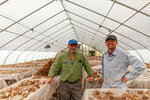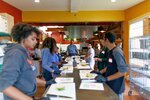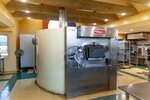At The Center for Discovery (TCFD), an organization dedicated to innovative care for individuals with developmental disabilities, a unique program is transforming the relationship between food and …
This item is available in full to subscribers.
Please log in to continue |




At The Center for Discovery (TCFD), an organization dedicated to innovative care for individuals with developmental disabilities, a unique program is transforming the relationship between food and wellness. Under the leadership of Chef Cesare Casella, the Department of Nourishment Arts (DNA) integrates culinary excellence with therapeutic practices to nourish both body and soul.
Casella, a culinary expert with a storied career in New York City’s top kitchens, now channels his passion into creating meals that are as healing as they are delicious.
“It’s important in life to do something that you enjoy,” Casella said. “And this I enjoy—being here with all these people and doing something special.”
His deep commitment to the residents of The Center for Discovery is evident in every aspect of DNA, from the care taken in sourcing ingredients to the innovative ways in which food is prepared and served.
The philosophy behind DNA, according to TCFD, is grounded in the belief that food plays a crucial role in healing. Casella’s early experiences in his family’s trattoria in Lucca, Italy, instilled in him a profound respect for fresh, high-quality ingredients.
Now, at The Center for Discovery, he has crafted a program that involves residents in every stage of food production—from planting seeds to preparing meals, and ultimately, enjoying the fruits of their labor.
“We’re not just feeding people; we’re nourishing them,” Casella explains, emphasizing the holistic approach that defines DNA.
During a recent visit to the Center’s farms, at the wash barn, residents carefully cleaned and prepared freshly harvested vegetables, taking pride in their work. “These ingredients have memory and give stimulation to the brain,” Casella noted, highlighting the sensory and emotional benefits of such activities.
At the vinegar production facility, a key element of the Center’s agricultural operations, residents are involved in every stage of vinegar production, from pressing apples to bottling and labeling the final product. This work is both therapeutic and educational, offering residents the opportunity to develop fine motor skills while contributing to a valuable community resource.
Sam Rose, who oversees aspects of the vinegar production, says that on pressing days, the scale of the operation is impressive. “We’re making over 100 gallons of cider,” Rose said. “We have six or seven different classrooms coming in, and 40 or 50 different people participate. It’s all to help get the vinegar program going.”
Central to Casella’s work is a profound respect for the dignity and individuality of each resident. “To have a house where they have the kitchen, where they have their own room, that is a respect for the person,” he emphasized, highlighting the importance of personal space and autonomy in the residents’ lives.
Casella also addressed the common misconception that individuals who have difficulty expressing their needs are without them. “Some people think that because someone can’t express themselves well or ask for what they want directly, they don’t have needs,” he said. “But if you’re careful, you see when someone is happy, when they’re doing something they love. This work gives them that happiness and respect.”
The “Seed to Belly” program, a community-driven initiative, engages local farmers, healthcare providers, and educators in a collaborative effort to support the residents. This approach ensures that the food produced is not only nutritious but also tailored to the specific needs of each individual.
Alex Needham, the farm director, has been instrumental in shaping this mission. “The farm is a place where residents can connect with the land, develop skills, and find peace in their work,” Needham explained.
Needham also emphasized the farm’s role in the community: “We don’t focus on production for profit; it’s about creating meaningful work that gives everyone a sense of purpose.” This philosophy aligns with the Center’s broader mission of using therapeutic farming as a tool for personal growth and healing.
The CSA (Community Supported Agriculture) program is another facet of the Center’s outreach, allowing staff and community members to purchase shares of the farm’s organic produce. The initiative not only helps fund the Center’s operations but also strengthens its connection with the surrounding community. “We couldn’t do this alone,” Casella admits. “It’s the people we work with, the community, that make this possible.”
At the bakery, Kayla Shattuck, one of the Center’s bakers, was preparing loaves of bread using ingredients sourced from the farm. Shattuck, who works alongside head baker Joseph Rodriguez, explained how the bread is made using natural yeast and baked in a wood-fired oven imported from Spain. “We try to use as much as we can from the farm,” she said, pointing to the rosemary used in their garlic rosemary loaves. “We’re always churning out bread—about 52 loaves a day, plus pizza crusts and rolls.”
The sense of pride and fulfillment among the residents was palpable. Whether washing vegetables, labeling vinegar bottles, or preparing bread, the joy on their faces was unmistakable.
Casella’s work at the Center is about more than just food, he says—it’s about creating an environment where residents feel valued and empowered. The Healthy Six model, which integrates diet, exercise, emotional regulation, education, environment, and community, forms the foundation of the Center’s care. This holistic approach has led to significant improvements in the residents’ overall well-being, according to Casella, from better sleep patterns to enhanced cognitive function.
Casella’s vision for the program is to partner with more healthcare facilities and launch additional educational initiatives. “We’re just getting started,” he says with a smile. “There’s so much more we can do.”
Comments
No comments on this item Please log in to comment by clicking here